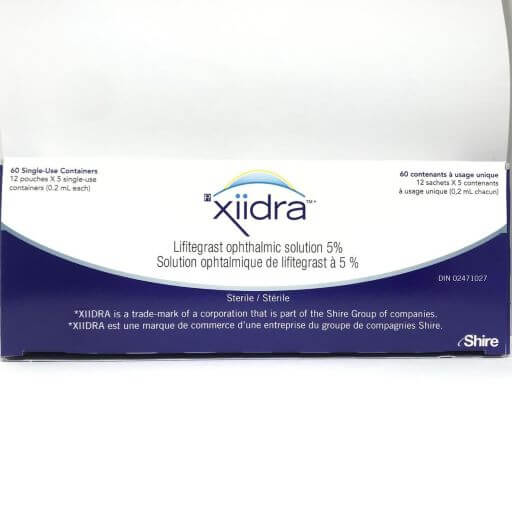Xiidra (generic name: lifitegrast ophthalmic solution) is prescribed to treat the eye condition known as Dry Eye Syndrome (keratoconjunctivitis sicca.) This condition occurs when tears produced by the tear glands don’t provide enough lubrication or are inadequate and unstable. The lacrimal glands (tear glands and tear ducts), located above the eyeball, continuously supply tear fluid that is wiped across the surface of the eye with every blink. When testing to determine the cause of dry eyes, doctors may include: A full eye examination A measurement of the volume of tears (known as the Schirmer test or the phenol red thread test.) A test of the quality of the tears, including evaporation times. A tear osmolarity test to measure the composition of tears. In people with dry eye syndrome, there will be lower levels of water in the tears, elevated matrix metalloproteinase-9 or decreased lactoferrin. Dosage Doses should be taken exactly as prescribed by the doctor.
Brand Manufacturer: Shire
Side Effects: This text is for informational purposes only. Please consult your doctor or pharmacist before using any medication. Some of the common side effects of Xiidra may include: blurred vision eye irritation an unusual or unpleasant taste in the mouth. Before starting to use, read the manufacturer’s Product Insert that comes with the medication. Please note that not all side effects can be listed here. Consult a healthcare provider if you experience any of these or other unexpected side effects. Xiidra may cause serious side effects. If you experience any of the following side effects, stop using Xiidra immediately and call your healthcare provider or pharmacist: vision problems severe eye redness or irritation.
Indication: The main symptoms of Dry Eye Syndrome include: Stinging, burning or scratching sensations Producing stringy mucus on the lids Sensitivity to light or difficulty driving at night Red eyes A sensation of grittiness Difficulty wearing contact lenses Watery eyes Blurred vision Eye fatigue Some general health factors make it more likely that dry eye disease may occur, such as: Age-related – people older than 50 have lower levels of tear production. Sex-related. Dry Eye Disease is more common in women, especially those who experience hormonal changes due to the use of birth control pills, pregnancy, or menopause. Diet-related – which can be caused by vitamin A deficiency. Use of contact lenses or having had corrective vision surgery in the past.

